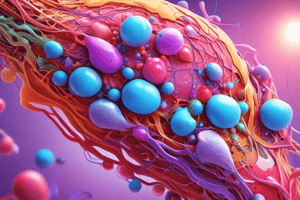Podcast
Questions and Answers
What is the primary action of agonists in the body?
What is the primary action of agonists in the body?
- They block the action of hormones.
- They compete with neurotransmitters for receptor sites.
- They bind to receptors and trigger a cellular response. (correct)
- They inhibit receptor binding.
Which of the following represents the use of an antagonist in medicine?
Which of the following represents the use of an antagonist in medicine?
- Phenylephrine for nasal congestion.
- Anti-androgens for prostate cancer. (correct)
- Acetylcholine for muscle contraction.
- Adrenaline for stress response.
What role do muscarinic receptors primarily play in the body?
What role do muscarinic receptors primarily play in the body?
- They initiate muscle contraction in response to nerve impulses.
- They block the action of adrenaline in the heart.
- They facilitate neurotransmission at the neuromuscular junction.
- They bind acetylcholine in the autonomic nervous system. (correct)
Which statement about antagonists is true?
Which statement about antagonists is true?
Which receptor interaction is an example of antagonistic action?
Which receptor interaction is an example of antagonistic action?
What is the primary role of hormones produced by endocrine glands?
What is the primary role of hormones produced by endocrine glands?
Which of the following statements accurately describes a difference between the nervous and endocrine systems?
Which of the following statements accurately describes a difference between the nervous and endocrine systems?
What is the main function of pheromones in communication?
What is the main function of pheromones in communication?
Which statement reflects the cooperation between the nervous and endocrine systems?
Which statement reflects the cooperation between the nervous and endocrine systems?
How does the speed of response differ between the nervous and endocrine systems?
How does the speed of response differ between the nervous and endocrine systems?
What does the 'free hormone' refer to in the context of hormone physiology?
What does the 'free hormone' refer to in the context of hormone physiology?
How does the presence of bound hormone influence its overall physiological effects?
How does the presence of bound hormone influence its overall physiological effects?
Which statement accurately describes feedback mechanisms in hormone secretion regulation?
Which statement accurately describes feedback mechanisms in hormone secretion regulation?
What is the effect of synergism among hormones?
What is the effect of synergism among hormones?
What role does humoral stimuli play in hormone regulation?
What role does humoral stimuli play in hormone regulation?
How do characteristic rates of decay influence hormone dynamics?
How do characteristic rates of decay influence hormone dynamics?
In hormonal control, what is typically the result of permissiveness?
In hormonal control, what is typically the result of permissiveness?
What is a common effect of increased blood flow on hormone delivery?
What is a common effect of increased blood flow on hormone delivery?
What distinguishes the autocrine mechanism of signaling?
What distinguishes the autocrine mechanism of signaling?
Which of the following best defines paracrine communication?
Which of the following best defines paracrine communication?
What is the role of prostaglandin in cell communication?
What is the role of prostaglandin in cell communication?
Which of the following features is NOT associated with endocrine signaling?
Which of the following features is NOT associated with endocrine signaling?
In the context of cell communication, cytokines are primarily associated with which system?
In the context of cell communication, cytokines are primarily associated with which system?
What characterizes the integration of stimuli in multi-cellular organisms?
What characterizes the integration of stimuli in multi-cellular organisms?
Which of the following statements is true regarding the immune cells in communication systems?
Which of the following statements is true regarding the immune cells in communication systems?
Why is the endocrine system described as having a long-distance signaling capability?
Why is the endocrine system described as having a long-distance signaling capability?
Flashcards
Cell-Cell Communication in Multicellular Organisms
Cell-Cell Communication in Multicellular Organisms
The process by which cells in complex organisms communicate with each other over long distances to coordinate their behavior and respond to internal or external changes.
Major Communication Systems
Major Communication Systems
The main systems involved in cell-cell communication, including the nervous system, endocrine system, and immune system.
Neurotransmitters
Neurotransmitters
Chemical messengers released by neurons to communicate with other neurons or target cells.
Hormones
Hormones
Signup and view all the flashcards
Cytokines
Cytokines
Signup and view all the flashcards
Autocrine Signaling
Autocrine Signaling
Signup and view all the flashcards
Paracrine Signaling
Paracrine Signaling
Signup and view all the flashcards
Endocrine Signaling
Endocrine Signaling
Signup and view all the flashcards
Neuro-Endocrine Mechanism
Neuro-Endocrine Mechanism
Signup and view all the flashcards
Similarities between Nervous and Endocrine Systems
Similarities between Nervous and Endocrine Systems
Signup and view all the flashcards
Differences between Nervous and Endocrine Systems
Differences between Nervous and Endocrine Systems
Signup and view all the flashcards
Agonist
Agonist
Signup and view all the flashcards
Antagonist
Antagonist
Signup and view all the flashcards
Muscarinic Receptor
Muscarinic Receptor
Signup and view all the flashcards
Nicotinic Receptor
Nicotinic Receptor
Signup and view all the flashcards
How do agonists and antagonists differ?
How do agonists and antagonists differ?
Signup and view all the flashcards
Hormone Concentration
Hormone Concentration
Signup and view all the flashcards
Free Hormone
Free Hormone
Signup and view all the flashcards
Bound Hormone
Bound Hormone
Signup and view all the flashcards
Negative Feedback Loop
Negative Feedback Loop
Signup and view all the flashcards
Positive Feedback Loop
Positive Feedback Loop
Signup and view all the flashcards
Humoral Stimuli
Humoral Stimuli
Signup and view all the flashcards
Neural Stimuli
Neural Stimuli
Signup and view all the flashcards
Hormonal Stimuli
Hormonal Stimuli
Signup and view all the flashcards
Study Notes
Hypothalamic Hormones and Pituitary Hormones
- The hypothalamus produces releasing and inhibiting hormones that regulate the anterior pituitary.
- The anterior pituitary produces hormones that stimulate target organs.
- GnRH, CRH, TRH, PRH, Dopamine, and GHRH are hypothalamic hormones.
- FSH/LH, ACTH, TSH, Prolactin, and GH are anterior pituitary hormones.
- Target organs include gonads, adrenal cortex, thyroid, and mammary glands (and all other parts of body)
- The posterior pituitary releases ADH and oxytocin.
Cell-Cell Communication
- Multicellular organisms require long-range signaling mechanisms to coordinate cell behavior.
- Specialized cell types evolved to enable intercellular communication over large distances.
- Major communication systems include the nervous system, endocrine system, and immune cells.
- These systems use neurotransmitters, hormones, and cytokines to integrate stimuli and respond to environmental changes.
Autocrine Signaling
- Cells release signals that have a localized effect on the same cell type.
- The signals are rapidly inactivated.
- Prostaglandins are an example.
Prostaglandin Autocrine Control
- Prostaglandins are autocrine signals.
- COX-2 upregulates prostaglandin synthesis.
- Prostaglandins stimulate cell growth.
Paracrine Signaling
- Cells release signals that affect nearby cells.
- The signals are not transported via the bloodstream.
- Paracrine signaling in the pancreas regulates the release of hormones like insulin, glucagon, and somatostatin, from different cells.
Endocrine Signaling
- Hormones produced by endocrine glands enter the bloodstream and affect distant target cells with specific receptors.
- Endocrine hormones cause a longer-lasting response than neurotransmitters.
Neuro-Endocrine Signaling
- Stimuli sensed by the nervous system lead to specialized neuroendocrine cells producing hormones.
- Neuroendocrine cells signal an appropriate response.
Pheromones
- Chemicals secreted in sweat and other bodily fluids.
- Thought to influence behavior in the same species.
Nervous and Endocrine Communication - Similarities
- Both systems have an association with the brain—specifically the hypothalamus.
- Both involve common messengers like epinephrine, which can act as a neurotransmitter and hormone.
- The systems are cooperative, with the nervous system releasing neurohormones into the bloodstream and the endocrine system innervated directly by the nervous system.
Nervous and Endocrine Communication - Differences
- Mode of transport: Axonal (unidirectional) for the nervous system and via the bloodstream or interstitial fluid for the endocrine system.
- Speed of response: Instantaneous (milliseconds) for the nervous system and delayed (seconds) for the endocrine system.
- Duration of response: Brief (milliseconds to seconds) for the nervous system and sustained (minutes to days) for the endocrine system.
Amplitude vs. Frequency Modulation
- Amplitude modulation: Hormone concentration changes over time and affects the strength of the signal.
- Frequency modulation: Changes in the frequency of hormone release, rather than the amount, affect the signal's overall strength.
Controlling Hormone Secretion
- The rate of hormone production (synthesis and secretion), the rate of delivery via blood flow, and the rate of degradation and elimination are essential aspects in controlling hormone secretion.
Free Hormone
- The unbound hormone is considered the active form.
- Feedback inhibition is regulated by free hormone concentrations.
- Clinically relevant to hormone excess or deficiency.
Bound Hormone
- Hormone bound to plasma proteins is inactive.
- Increases the serum half-life of the hormone.
- The rate of delivery to target cells is controlled by the bound hormone concentration.
Synthesis and Secretion of Hormones
- Hormone synthesis and secretion are tightly regulated by negative and positive feedback loops.
- This regulation is a major aspect of endocrine control.
Negative Feedback Loops
- The hormone negatively regulates its own production.
- For example, the thyroid hormone (T4 and T3) release is regulated by the hypothalamus and pituitary, with a negative feedback mechanism.
Positive Feedback Loops
- The hormone's release stimulates further release.
- Example is the release of oxytocin during childbirth and breastfeeding
Humoral Stimuli- Blood Chemistry
- Blood chemical concentrations trigger hormone release.
- For instance, low calcium levels stimulate parathyroid hormone (PTH) release.
Humoral Stimuli - Glucose Insulin
- High blood glucose levels stimulate insulin secretion.
Neural Stimuli Control
- Electrical signals from the nervous system can trigger hormone release.
Control by Hormonal Stimuli
- Hormone production is controlled by higher factors(regulatory hormones) from the hypothalamus.
- These induce production of tropic hormones from the anterior pituitary, which act on their target organ to release a hormone. (e.g. the anterior pituitary produces TSH, which stimulates the thyroid gland to produce hormone T4/3).
Hormone Interaction
- Synergism: Two or more hormones acting together have an amplified effect.
- Permissiveness: One hormone is necessary for another to exert its full effect
Agonists and Antagonists
- Agonists mimic the action of a hormone.
- Antagonists block or reduce the action of a hormone.
Agonists Mimic Response
- Mimic natural hormones, binding to their receptors.
- Trigger similar cellular responses to the natural hormone.
Antagonists Inhibit Response
- Compete with natural hormones for similar receptor sites.
- Prevent the activation of the receptor, blocking hormone action.
Receptors
- Muscarinic receptors: Bind acetylcholine in the autonomic nervous system.
- Nicotinic receptors: Bind acetylcholine at neuromuscular junctions and are blocked by curare.
Studying That Suits You
Use AI to generate personalized quizzes and flashcards to suit your learning preferences.




